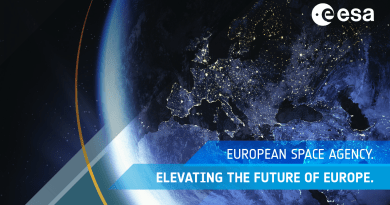Artemis I/SLS Booster Components Arrive Ahead of Stacking

JUNE 17, 2020–Northrop Grumman has delivered ten Space Launch System solid rocket segments for the Artemis I mission, along with two inert OmegA segments for booster training to the Kennedy Space Center after making a long train ride from Utah to Florida. The arrival of the boosters signals the beginning of the SLS vehicle assembly flow, a massive milestone for the Artemis program and specifically Artemis I. This comes after years of practicing and testing with mock-up segments.

The boosters’ aft skirts, which control thrust vectoring and hold down the boosters until launch, have recently moved from the Booster Fabrication Facility to the Rotation, Processing and Surge Facility (RPSF) on June 9, 2020, in preparation of the arrival of the ten solid rocket segments. The aft motor assembly will take shape after the segments arrive. After this, the segments will be put in storage until it’s time to stack the vehicle on top of the Mobile Launch Platform.

Jeff Angermeier, Flow Director at Exploration Ground Systems says that SLS will begin stacking “later this fall”. Booster parts that have recently arrived at KSC will be processed, but, due to a limitation on how long solid rocket boosters can remain stacked, the segments will be put in storage until this fall.
This date seems to assume that the Artemis I Core Stage arrives at the space center after completing it’s green run test campaign no later than November 2020. However, due to the multi-month pause and social distancing measures, the arrival may slip into December or into January 2021.
In the meantime, thee mobile launcher platform, ML-1, completed all of its “verification and validation” testing, meaning it is ready for flight. Artemis I’s second stage, the Interim Cryogenic Propulsion Stage arrived back in 2017 and has also been ready since then.
The Orion capsule is also in storage until the Artemis I Core Stage completes the Green Run tests. Once Orion is out of storage, it’ll be turned over to Exploration Ground Systems for fueling. Afterward, its Launch Abort System will be installed, and finally, it will make the trip to the Vehicle Assembly Building.
Another objective to be completed after the Green Run is booster stacking, which can occur ahead of the arrival of the Core Stage. Once the boosters are stacked and the Core Stage arrives, the boosters will be bolted on to the Stage, with the ICPS stage and Orion placed on top.
Once SLS stacking is complete, the final two objectives are the Wet Dress Rehearsal, and launch. Artemis I will launch from the historic Pad 39B, which flew Apollo 10, all Skylab crew missions, and many Shuttle missions.



